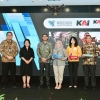In many schools, student affairs are still synonymous with piles of files, thick ledgers, and slow administrative processes---when in fact, students are both the subject and object of education, deserving fast and accurate services. This phenomenon has led to a false assumption that managing student affairs is merely administrative work, not a strategic component for improving school quality. As a result, problems such as scattered data, hindered parent--school communication, and non--data-driven decision-making emerge, all of which reduce the quality of services for students. The Student Management Information System (Sistem Informasi Management Kesiswaan/ SIMKES-in Indonesian) emerges as a solution to transform manual processes into smart, technology-based services that not only streamline administration but also simplify student progress monitoring, enhance teacher and staff efficiency, and strengthen collaboration among schools, parents, and the community.
SIMKES combines human resources and information technology to collect, process, and present student-related data as the foundation for school decision-making. According to Gordon B. Davis, SIMKES integrates humans and machines to support organizational operations, management, and decision-making. Komarudin emphasizes the importance of information with proper quality and quantity. Student management itself oversees the journey of learners from registration to alumni, covering input, process, output, and outcome. Based on Law No. 20 of 2003, students are members of society who develop their potential through learning. SIMKES ensures that student-related activities run smoothly, orderly, and efficiently while enhancing the school's credibility and accountability.
The scope of SIMKES extends beyond recording student data; it manages the entire lifecycle of students to support educational quality. Its activities include planning through data collection and needs analysis, new student admissions through registration, selection, orientation, class placement, as well as academic and extracurricular development. It also covers student progress recording and reporting---promotion, specialization, graduation, and alumni management. SIMKES includes student council (OSIS) development, attendance monitoring, counseling, scholarship management, and health services (UKS). These processes are supported by administrative tools such as student registers, achievement records, and transfer documents, ensuring student management that is organized, efficient, and accountable.
Leveraging information technology through SIMKES brings numerous benefits to schools. It enhances efficiency in time, energy, and cost, allowing teachers to focus more on teaching. Additionally, SIMKES improves communication between schools and parents, accelerates services, and supports data-driven decision-making. Expected outcomes include easier processing of student, staff, financial, and asset data, as well as performance analysis for education department reporting. Other features include library management, barcode or fingerprint attendance, parent--student portals, academic records, extracurricular tracking, and payment history---creating more transparent and human-centered services.
The SIMKES development model is designed to help schools manage student data from registration to alumni. It provides progress information for teachers, homeroom advisors, and parents, while supporting data-based decision-making. Modern features include web-based student admissions (Penerimaan Peserta Didik Baru/ PPDB-in Indonesian), multiuser input, integrated databases, barcode or fingerprint attendance, automatic digital report cards, online payments, and SmartSchool SMS notifications to ease communication. With support from a trained management team, SIMKES enables student services that are modern, efficient, transparent, and accessible to all stakeholders.
In conclusion, SIMKES serves as a vital foundation for modern student management, integrating technology and human resources to support school decision-making and strengthen educational credibility. It regulates the student lifecycle from planning to alumni in an orderly, efficient, and accountable manner. Its implementation accelerates services, simplifies data processing, strengthens parent--school communication, and supports data-driven educational quality. Through integrated features such as web-based admissions, digital attendance, automated report cards, and SmartSchool SMS, SIMKES modernizes student services to be inclusive, transparent, and accessible---meeting the needs of schools in the digital era.*)
_________
*)This article is summarized from the teaching module of the Educational Management Information System course, Part 5, lectured by Prof. Dr. H. A. Rusdiana, M.M (Reference: https://share.google/1BQhlimtw7JuLG2we)









